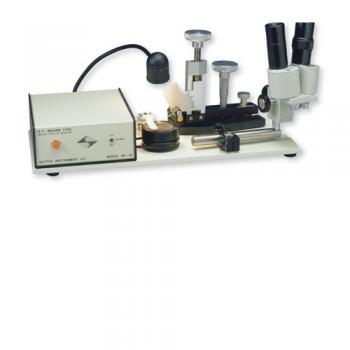Microelectrode Beveler Sutter BV-10
BV-10 machine for sharpening/polishing micropipette tips 0.1 - 100 ?�m. Vibration-free abrasive disc.
- Overview
- Specifications
- Links
The BV-10 is a stylish, easy-to-use tool for precisely beveling micropipette tips between 0.1 and 100 µm. For better beveling process control, a special vibration-free abrasive plate driving mechanism is used. Using the methods outlined by Brown and Flaming in Science, August 1974, Vol. 185, beveling can be done quickly while producing uniform tip diameters.
Because of the following, beveling is beneficial for intracellular recording electrodes:
- a narrowing of the tip diameter caused by the electrode's sharp point;
- a decreased electrical resistance of the electrode as a result of the lumen's increased cross sectional area.
This makes it much easier to enter and hold very small or problematic cells. Microinjection needles also profit from beveling since it helps them enter cells with less harm while also improving material flow through the needle.
A stationary pedestal installed on a large baseplate that is optically flat to a half wave (250 nm) makes up the fundamental beveling mechanism. This acts as a bearing for a glass grinding plate with an abrasive coating that is likewise flat to half a wave. Magnetic fields are used to couple the flat abrasive plate to a slow-speed, low vibration motor, creating a flat grinding surface that is wobble-free. A patented method is used to produce the abrasive plates, ensuring a uniform abrasive coating.
The pipette that needs to be beveled is held by a 2-axis micromanipulator, which allows for controlled advance onto the abrasive surface. Both the bevel angle and the rate of advancement can be altered. The beveling process is improved by an LED lamp with a gooseneck because it casts a sharp light on the pipette and abrasive plate.
Two of your preferred abrasive plates, a wick with holder (for wet beveling), pedestal oil, degreasing fluid, and a manual round up the basic system.
An electrode impedance meter and a 40X stereo microscope can both be used to observe the beveling procedure. One or both of these solutions may be preferable according to your research application. The swing mounted microscope improves your control of pipette advancement onto the abrasive plate for all micropipette applications and enables you to see the beveling process (scope resolution is not sufficient for viewing the actual bevel except in the case of very large tips). During the beveling process, the impedance meter is utilized to check the tip resistance for microelectrode applications. Three resistance ranges are available on the analog meter (0-10, 0-100, 0-500 MOhm). To reduce capacitive influences to the impedance measured and obtain a close to accurate DC resistance value, measurements are done at 12 Hz. In order to eliminate 50/60 Hz interference and enable operation in a lab setting without screening, a quick roll-off is used.
COMMON APPLICATIONS of BV-10:
- Deep brain injections
- ES cell and ICSI procedures
- C elegans injections
- Fish and insect egg injections
FEATURES
- Magnetically aligned, vibration-free beveling surface.
- Optically flat abrasive surface to a half wave (250 nm).
- Finest commercially obtainable abrasive surface.
- An synchronized clock motor ensures a constant rotational speed.
- More dampening is added by the 7 pound steel baseplate.
- Built-in LED light.
- Bevel angle and progress are controlled by a powerful micromanipulator.
You can also visit site of the manufacturer.



